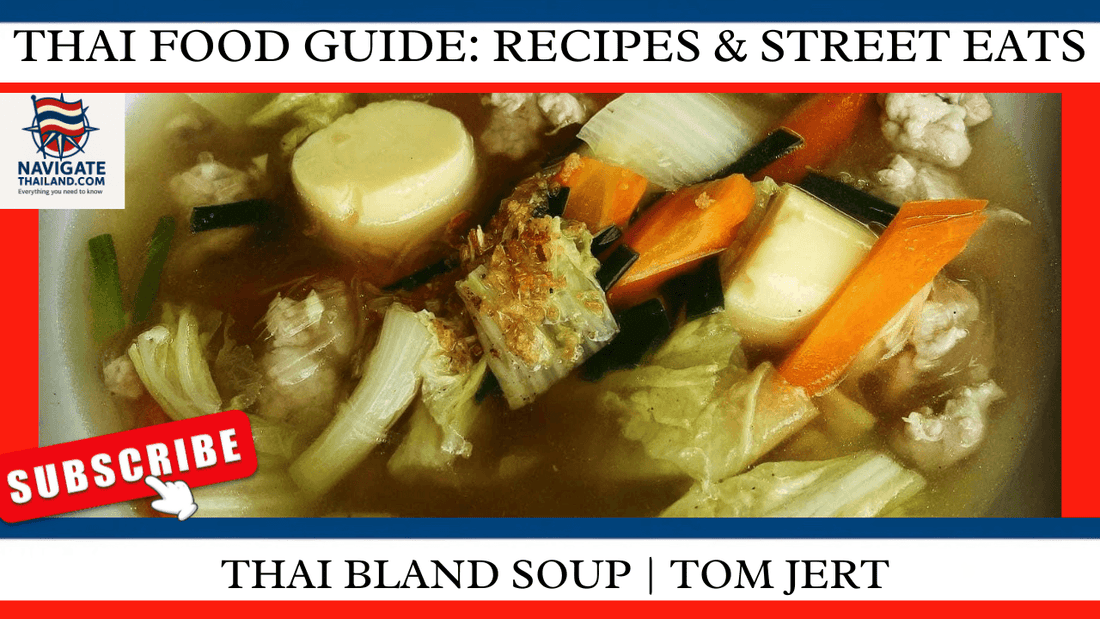
Tom Jert: Thailand’s Light and Comforting Clear Soup
Share
When people think of Thai cuisine, bold and fiery flavors often come to mind—whether it’s the spicy kick of Tom Yum or the creamy richness of Tom Kha. But there’s another, often overlooked gem in Thai cooking: Tom Jert. Known as Thailand’s clear soup, Tom Jert offers a refreshing alternative with its mild, soothing flavors. This delicate, nourishing dish is a staple in many Thai households, beloved for its simplicity and comfort, often serving as a remedy for those feeling under the weather.
In this blog, we’ll take a closer look at the origins, ingredients, and health benefits of Tom Jert. Whether you’re traveling through Thailand or looking to recreate authentic Thai flavors at home, this light and nutritious soup is a must-try for anyone seeking a wholesome, everyday meal.
What is Tom Jert?
Tom Jert (ต้มจืด), which translates to “bland soup,” is anything but bland. It’s a simple, clear soup typically made with a light broth, tofu, vegetables, and either minced pork or chicken. The dish is gently seasoned with garlic, ginger, and a splash of fish sauce or soy sauce, allowing the natural flavors of the ingredients to shine through. Unlike spicier Thai dishes, Tom Jert offers a mild, refreshing experience that complements more intense flavors when served as part of a larger meal.
In Thai households, Tom Jert is often enjoyed alongside stir-fried dishes or rice. Its gentle warmth makes it a go-to dish for those seeking something easy on the stomach or in need of a light, comforting meal.
Fun Fact: In Thailand, Tom Jert is often considered the ultimate comfort food for people feeling unwell, much like chicken soup in Western cultures. Its nourishing, easily digestible ingredients make it perfect for recovery.
The Origins of Tom Jert
Like many dishes in Thai cuisine, Tom Jert has its roots in Chinese culinary traditions. Thailand’s food culture has been heavily influenced by neighboring countries, particularly China, and this clear soup is a prime example of that fusion. Ingredients like tofu, glass noodles, and clear broths—common in Chinese cooking—are often found in Tom Jert.
In Thailand, Tom Jert is a versatile dish, commonly prepared at home due to its simplicity and adaptability. Cooks often use whatever vegetables and proteins they have on hand, making it an ideal dish for families looking for a quick, nutritious meal. While it may not enjoy the international fame of dishes like Pad Thai or Green Curry, Tom Jert is cherished for its role in everyday Thai home-cooking.
Nutritional Benefits of Tom Jert
Tom Jert is not only delicious but also incredibly nutritious. Its light broth, fresh vegetables, and lean protein make it a low-calorie, hydrating meal. Here’s a general nutritional breakdown of Tom Jert (per serving, approximately 250 grams):
• Calories: 150-200 kcal
• Protein: 10-15 grams (depending on the protein used)
• Carbohydrates: 10-15 grams (if noodles are included)
• Fat: 5-10 grams
• Fiber: 3-5 grams (from vegetables)
• Sodium: 400-600 mg (from fish sauce or soy sauce)
The dish is naturally gluten-free (when made with gluten-free soy sauce) and can easily be adapted for vegetarians by replacing fish sauce with soy sauce and using tofu as the protein source.
Fun Fact: Some variations of Tom Jert use glass noodles (also known as mung bean noodles), which are low in calories and carbohydrates, making them a great addition for those looking for a lighter, healthier meal.
How to Make Tom Jert at Home
Tom Jert is one of the easiest Thai dishes to make at home. It requires only a few simple ingredients and minimal preparation, making it ideal for quick weeknight meals. Its versatility also means you can adjust it to your preferences, whether you prefer pork, chicken, tofu, or a variety of vegetables.
Ingredients (serves 2-3):
• 1 litre of chicken broth (or vegetable broth for a vegetarian version)
• 200 grams minced pork or chicken (or tofu for a vegetarian option)
• 2-3 cloves garlic, minced
• 1 small piece of fresh ginger (about 1 inch), thinly sliced
• 1 tablespoon soy sauce (or fish sauce)
• 1 small carrot, thinly sliced
• 1 small napa cabbage, chopped
• 1 block of tofu, cubed (optional)
• 50 grams glass noodles (optional)
• 1-2 spring onions, chopped (for garnish)
• Fresh coriander (optional, for garnish)
• White pepper (to taste)
Instructions:
1. Prepare the Ingredients: Chop the vegetables and cube the tofu (if using). Soak the glass noodles in warm water for 10-15 minutes until softened, then drain.
2. Make the Broth: In a medium pot, bring the chicken or vegetable broth to a boil. Add the minced garlic and ginger, and let it simmer for about 5 minutes to infuse the flavors.
3. Cook the Protein: Add the minced pork or chicken to the broth, breaking it into small pieces as it cooks. If using tofu, add it at this stage. Simmer for about 7-8 minutes until the meat is fully cooked.
4. Add the Vegetables: Stir in the carrot and napa cabbage. Let the soup cook for another 5 minutes until the vegetables are tender but still slightly crisp.
5. Season the Soup: Add soy sauce or fish sauce and a pinch of white pepper. Taste and adjust seasoning as needed.
6. Add the Noodles: Stir in the glass noodles during the final 2-3 minutes of cooking.
7. Serve: Ladle the soup into bowls and garnish with spring onions and fresh coriander. Enjoy hot, either on its own or with rice and other Thai dishes.
Fun Fact: In some regions of Thailand, Tom Jert is also made with daikon radish, adding a subtle sweetness and earthy flavor to the broth.
Variations of Tom Jert
Tom Jert is a highly adaptable dish, making it easy to tailor to your taste or dietary needs:
• Vegetarian Tom Jert: Substitute minced pork with tofu, use vegetable broth, and replace fish sauce with soy sauce for a plant-based version.
• Spicy Tom Jert: If you like a bit of heat, add some bird’s eye chilli or a dash of chilli oil for a spicy twist.
• Seafood Tom Jert: Swap the pork or chicken for shrimp or fish to create a seafood version that pairs beautifully with the light broth.
Why Travellers Should Try Tom Jert
While Thailand is known for its spicy and robust dishes, Tom Jert offers a light, comforting alternative that’s perfect for those looking to ease into Thai cuisine. It’s often found at local food stalls, family-style restaurants, and even rural villages where traditional cooking thrives. If you’re traveling through Thailand and need a break from spicy food, Tom Jert provides a soothing, flavorful experience that showcases the diversity of Thai cuisine.
Fun Fact: Many travellers describe Tom Jert as their “comfort food” while in Thailand, enjoying its mild flavors as a contrast to the fiery dishes like Pad Krapow or Som Tum.
Conclusion
Tom Jert may not have the bold punch of Thailand’s more famous dishes, but its light, nourishing qualities make it a beloved comfort food for many Thai families. Whether you’re enjoying it at a street food stall in Bangkok or cooking it in your own kitchen, Tom Jert offers a taste of the everyday warmth and simplicity that defines much of Thai home cooking.
Have you tried Tom Jert on your travels or made it at home? Share your experience in the comments below! And don’t forget to share this blog on social media to help others discover this hidden gem of Thai cuisine. Subscribe to our YouTube channel for a step-by-step video guide to making authentic Tom Jert at home.
References:
• Lonely Planet: “Exploring Thailand’s Comfort Foods”
• National Geographic: “A Guide to Thai Soups and Their Origins”
• Thai Culinary Institute: “Tom Jert and the Role of Clear Soups in Thai Cooking”
Read more of our Thailand blog series:
Thai Food Guide:Traditional Recipes and Street Eats
Everything Travellers Need to know
Thailand travel ebooks and language guides
Thailand Travel Apparel & Souvenir Gifts
Subscribe to our YouTube channel Navigate Thailand to see our most popular Thailand travel blogs turned into videos:
















































































































































